Taiwanese pineapple cake is a favorite bakery delicacy all year round. It is a crumbly and nearly melt-in-the-mouth pastry with the pineapple jam as the filling encased inside.
The Taiwanese pineapple cake is different from the Singapore/Malaysia pineapple tart that I used to make. First, the filling contains mashed winter melon instead of pure pineapple. Secondly, it is shaped into a square with a mold, whereas the Singapore/Malaysia version is mostly open-faced. In this recipe, I will use pineapple alone instead of a mixture of pineapple and winter melon, as pure pineapple tastes better.
I will make the Taiwanese pineapple cake primarily based on the Taiwanese formula, with my interpretation. Therefore, it may not be totally authentic. I will also provide a few tips on how to make it more crumbly and melt-in-the-mouth, or firmer which will not shatter easily as a gift. Besides, there will be some tips on how to improvise the recipe if you are unable to get the mold that you need for the recipe. (Hint: You can DIY the mold).
Let’s get started.
Note: Taiwanese pineapple cake is also translated into English as Taiwanese pineapple shortbread, shortcake or tart. They are referring to the same 鳳梨酥 in Chinese.
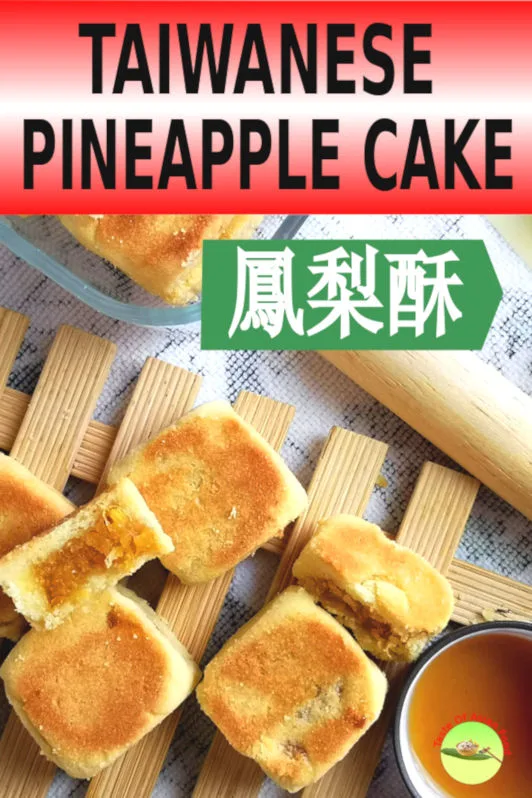
Note: This post may contain affiliate links. Please read my privacy policy for more info. I may receive commissions for purchases made through links in this post.
Why is Taiwanese Pineapple Cake popular during festive?
Taiwanese pineapple cake is called 鳳梨酥 in Chinese. 鳳梨 means pineapple. These two Chinese words are phonetically resembling 旺來, which means ‘good fortune arrives.’ As a result, this delicacy is hugely popular during the Chinese New Year due to its phonetic proximity to the auspicious meaning of 旺來. However, it is equally common throughout the year in many Taiwanese bakeries due to is exceptional flaky pastry and its unique flavor.
As for the last Chinese word 酥, it means any pastries that are flaky or short, regardless it is baked or deep-fried.
Step by step guide: How to make Taiwanese Pineapple Cake
1. Prepare the filling
Cut the pineapple
- Slice Off the crown and bottom.
- Trim off the thick fibrous skin, be careful to preserve as much flesh as possible.
- Remove the brown circular ‘eyes.’ Use a small knife to make a V-shape shallow diagonal cut at both sides of the row of eyes. Cut out the eyes with a knife at where the diagonal cuts meet below the eyes.
- Cut the pineapple into four vertically.
- Separate the core from the flesh. Cut both into small chunks.
- Place the core into the food processor. Blend it into small pieces. The core is harder than the flesh, which needs a longer time to blend into small pieces.
- Add the flesh and continue to blend until there are no visible pieces.
Note:
You can ask the fruit vendor to remove the skin and the eyes. My regular fruit store is willing to do it at no cost. I hope you can get the same service too.
You can also use the pineapple cubes in the can. You will save the time to cut the pineapple. Discard the liquid and use only the pineapple cubes.
Make the pineapple jam (the filling)
- Transfer the blended pineapple to a non-stick pan. I suggest using a non-stick pan for cooking the pineapple as it is sticky after when it becomes concentrated.
- Cook the pineapple paste over high heat initially, so that the pineapple juice will reduce quickly. I prefer cooking this way rather than remove the pineapple juice by letting the pineapple pulp going through a strainer. Some recipes include a step to put the pineapple pulp into a cloth bag and then remove partially the juice. The purpose is to shorten the cooking time of the pineapple. I do not want to do that as I want to retain all the juice for better flavor.
- When the pineapple paste is about to dry, reduce to low heat, and continue to simmer. Now add the sugar, lemon juice, and maltose.
- Now add some unsalted butter. The butter makes the pineapple paste smoother and easier to handle during wrapping.
- Important: Do a taste test to decide whether you need to adjust the sweetness and sourness. Since the sweetness of each pineapple is different, the right amount of sugar mostly relies on the final taste testing.
The filling is ready when it becomes thick enough which you can pile up with a spatula, like jam.
When it cools down, place it in the refrigerator for an hour until it becomes slightly harden. It is now ready to use.
Note: Maltose is very sticky, which helps to bind the pineapple paste together, and make it easy to handle while wrapping it with the pastry. Besides, it also has a rich caramelized flavor.
Melt the maltose in the microwave oven or over the stove until it is less sticky so that it is easier to pour it into the pan.
2. Prepare the pastry
The pastry is similar to the shortcrust pastry, prepared by creaming method.
- Cut the unsalted butter in the mixing bowl and let it return to room temperature before use. It should be very soft before mixing with the sugar so that more air will trap into the structure to form a lighter pastry. If you use salted butter, omit the salt in the recipe.
- Add the castor sugar to the butter and stir it with the mixing blade with before switching on the mixer. This step will prevent the sugar from splashing out from the mixing bowl.
- Cream the butter and sugar until it becomes light and fluffy, which resemble soft ice cream. Scrape the side of the mixing bowls from time to time. The color of the mixture will also turn from bright yellow to pale yellow.
- Next, add the egg yolk and continue mixing until homogenous.
- Shift the milk powder, cake flour, cornstarch, salt, and add to the buttercream mixture. Mix until all the ingredients are combined. Do not overmix to avoid the formation of gluten, which will make the pastry less flaky.
- Flatten the soft pastry and wrap with cling film. Keep it in the refrigerator for two hours, or until it is hardened, The pastry is now ready to use.
Note: Most of the Taiwanese pineapple cake has a distinctively milky taste, and therefore, milk powder is an essential ingredient in the recipe.
An alternative formula (firmer pastry)
The recipe in this article will produce a crumbly pastry. However, it is very fragile and may break if you want to pack it as a gift for someone.
Therefore, I have included an alternative recipe in the note section below the instruction. This recipe yields pastry that is firmer and less crumbly.
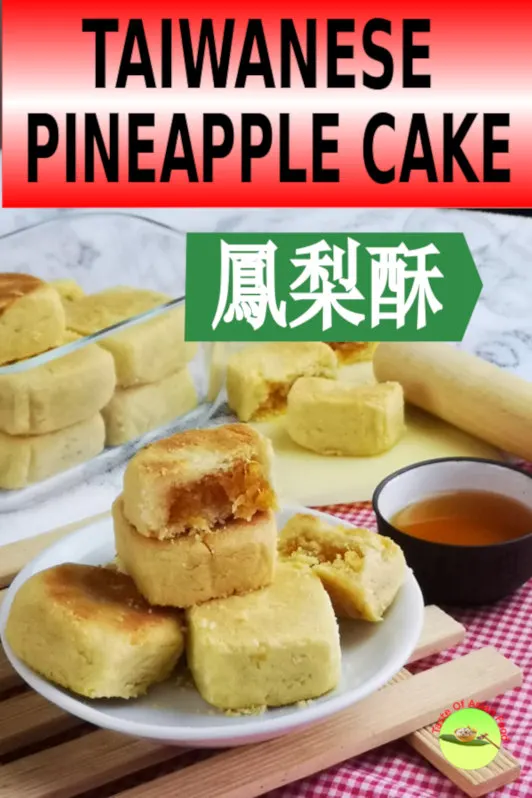
3. Molding
The quantity of the pastry and the filling in this recipe is enough to make eighteen to twenty small pineapple cakes, based on the size of the molds that we use, i.e., 4cm x 4cm.
Since the size of your mold may be different from what I use. Follow these steps to decide the weight of the pastry and filling for each cake.
- Fill up the mold by using a small piece of the dough. Leveled and remove the excess dough.
- Let’s say the weight is 30g, then the amount of pastry is 18g, and the filling is 12g. (18g+12g=30g). The ratio I use here is three parts of pastry to two parts of filling.
You can use an equal portion of the pastry and fillings for each cake, but it is more challenging to encase the filling within the pastry perfectly.
How to make the pineapple cake mold by yourself
If you plan only making the pineapple cakes occasionally, you can opt not to buy the mold, but make your own with cardboard and aluminum foil. Here are the steps:
- Get a piece of cardboard, cut to 2cm wide, and 18cm long.
- Make the folding marks at the 4cm intervals, and the remaining 2cm at the end will be used to connect both ends of the cardboard to form a square,
- Make the folds at each 4cm intervals.
- Then wrap it up with aluminum foil
- Connect both ends with cellophane tape or stapler.
4. Wrapping the pineapple cake filling
- Weight 12g of the pineapple filling, then roll it to form a ball with two spoons.
- Keep it in the refrigerator if you do not use it immediately.
- Weight 18g of pastry and roll it to a round shape. Use a rolling pin to roll it to a circle.
- Place one portion of the filling on top of the roll-out pastry.
- Fold the pastry to encase the filling inside.
- Place the pineapple dough in the mold and lightly press the top so that the pastry takes the shape of the mold. Pay attention that the pastry is taking up the space of the four corners.
There is no unique technique in this step, as long as you can cover the filling with the pastry, preferably of equal thickness at any parts.
Check out other Chinese dessert on this blog:
- Chinese egg tart – a traditional favorite Hong Kong style Dim Sum.
- Curry puffs – deep fried Malaysian Chinese style dessert
- Mango pudding – a popular item on the menu of the Chinese dessert house.
5. Baking
- Preheat the oven by adjusting the top and bottom temperature to 165°C/330°F.
- Place the molded pineapple cakes on a tray, line with baking paper. Leave some space in between each of them to allow efficient heating in the oven.
- Bake the cakes for ten minutes at middle rack. Check whether the pastry is now firm and no longer sticking to the paper. If you find that it is still soft and sticky, bake for a few more minutes until it is firm and can be overturned easily.
- Turn the cake over with a pair of tongs. Turning the cakes should be a swift action so that the temperature will not drop too much outside the oven, which will cause the pineapple cakes to shrink.
- Place the pineapple cake into the oven again to bake for another five to ten minutes, or until golden brown.
- Remove the pineapple cake from the oven. Let the cakes cool to temperature before keeping it in an airtight container. The cakes will stay fresh in room temperature for about three to five days.
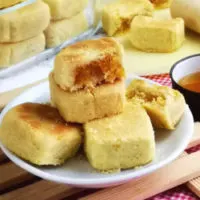
Taiwanese Pineapple Cake
Taiwanese pineapple cake is a favorite bakery delicacy all year round. It is made with a crumbly and nearly melt-in-the-mouth pastry with the pineapple jam as the filling encase inside.
Ingredients
Pastry:
- 100g unsalted butter
- 30g castor sugar
- 1/4 tsp salt
- 1 egg yolk
- 25g milk powder
- 100g cake flour
- 20g cornstarch
Filling:
- 1 pineapple
- 60g (4 tbsp) maltose
- 30g sugar
- 10g (2 tsp) lemon juice
- 10g unsalted butter
Instructions
Prepare the filling
- Slice Off the crown and bottom of the pineapple.
- Trim off the thick fibrous skin. Cut out the eyes.
- Place the core into the food processor. Blend it into small pieces.
- Cook the pineapple paste over high heat initially, so that the pineapple juice will reduce quickly. When the pineapple paste is about to dry, reduce to low heat, and continue to simmer.
- Now add the sugar, lemon juice, and maltose.
- Add some unsalted butter.
- The filling is ready when it becomes thick enough like jam.
- Refrigerate for an hour until it becomes slightly harden. It is now ready to use.
Prepare the pastry
- Add the castor sugar to the butter. Cream the butter and sugar until it becomes light and fluffy, which resemble soft ice cream. Next, add the beaten egg and continue mixing until homogenous.
- Sieve the flour, cornstarch, milk powder, and salt, and add to the buttercream mixture. Mix until all the ingredients are combined.
- Keep it in the refrigerator for two hours, or until it is hardened.
Wrapping the filling
- Transfer one portion of the filling to the center of the pastry.
- Fold the pastry to encase the filling inside.
- Place the pineapple dough in the mold and light press the top so that the pastry take the shape of the mold.
Baking
- Preheat the oven by adjusting the top and bottom temperature to 165°C/330°F.
- Place the molded pineapple cakes on a tray, line with baking paper. Leave some space in between each of them to allow efficient heating in the oven.
- Bake the cakes for ten minutes at middle rack. Remove and turn the cake over with a pair of tongs.
- Bake for another five to ten minutes, or until golden brown.
Notes
1. The pastry yields 18-20 cakes.
2. The pineapple weighted 900g after purchase yields 470g of flesh, and eventually cooked down to 260f of filling.3. This list is the ingredients for a firmer pastry. The method of preparation is the same as the main recipe.
Pastry:
100g unsalted butter
30g castor sugar
1/4 tsp salt
1 whole egg
25g milk powder
120g cake flour
Recommended Products
As an Amazon Associate and member of other affiliate programs, I earn from qualifying purchases.
-
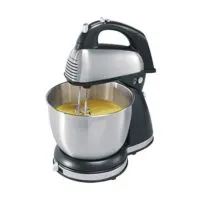 Hamilton Beach 64650 6-Speed Classic Stand Mixer, Stainless Steel, 4-Quart Bowl and Accessories
Hamilton Beach 64650 6-Speed Classic Stand Mixer, Stainless Steel, 4-Quart Bowl and Accessories -
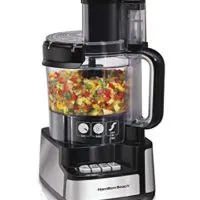 Hamilton Beach 70725A 12-Cup Stack & Snap Food Processor and Vegetable Chopper Black
Hamilton Beach 70725A 12-Cup Stack & Snap Food Processor and Vegetable Chopper Black -
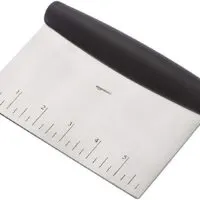 AmazonBasics Multi-purpose Stainless Steel Bench Scraper and Chopper
AmazonBasics Multi-purpose Stainless Steel Bench Scraper and Chopper -
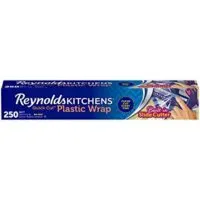 Reynolds Kitchens Quick Cut Plastic Wrap - 250 Square Foot Roll
Reynolds Kitchens Quick Cut Plastic Wrap - 250 Square Foot Roll
Nutrition Information:
Yield: 18 Serving Size: 1 cakeAmount Per Serving: Calories: 89Total Fat: 5gSaturated Fat: 3gTrans Fat: 0gUnsaturated Fat: 2gCholesterol: 23mgSodium: 35mgCarbohydrates: 10gFiber: 0gSugar: 4gProtein: 1g
This data was provided and calculated by Nutritionix on 6/30/2019

Cal
Sunday 9th of February 2025
Hello! Two questions for this recipe: 1. Can you use frozen pineapple? 2. Are there any substitutes for the milk powder?
Thank you!
KP Kwan
Wednesday 19th of February 2025
I have not try substituted milk powder with anything else. If it is unavailable, I will use a tablespoon of flour and a tablespoon of cornstarch instead.
Popcorn chicken (Taiwanese style) - How to make it at home
Monday 29th of July 2024
[…] Taiwanese pineapple cake is a favorite bakery delicacy all year round. It is a crumbly, nearly melt-in-the-mouth pastry with pineapple jam as the filling encased inside. […]
SL
Saturday 2nd of September 2023
Hi, what type of pineapple is better for this recipe? those sweet honey pineapples, or the "normal" ones? thank you
KP Kwan
Friday 8th of September 2023
As long as it is sweet whould be OK.
J
Sunday 2nd of July 2023
How would I use gluten free flour to substitute for the flour in this recipe, if possible? Is there a certain blend I would have to make, or should I just add a bit of cornstarch in the gluten free blend to make pastry flour?
J
Wednesday 5th of July 2023
@KP Kwan, I just tried it with both normal pastry flour and gluten free flour but it was a blend of 80% gluten free flour and 20% corn starch (the corn starch was addition to the corn starch already mentioned in the recipe). Turned out okay but when making it was stickier and harder to mold into a shape. Also when it came out of the oven, it was extremely fragile and would break easily, after cooling its better but still not as together as normal pastry flour.
Thank you for the amazing recipe!
KP Kwan
Sunday 2nd of July 2023
I'm not certain of the answer as I haven't tried it before. Can anyone help me with an answer?
Bryan
Thursday 21st of April 2022
100g unsalted butter 30g castor sugar 1/4 tsp salt 1 egg yolk 25g milk powder 100g cake flour 20g cornstarch
For the castor sugar, could we replace it with a 1-1 monk fruit sugar substitute?
What does the egg yolk do?
For the milk powder, what kind of milk powder is this?
What is the function of the cake flour?
KP Kwan
Saturday 23rd of April 2022
I have not tried the sugar you mention, but I guess it should work well with any sugar. You can use any milk powder, like those for kids. I got mine from the bakery supplier. This recipe is what I use, and the combination of ingredients is working fine so far. However, I am not getting into detail about the function of each ingredient.